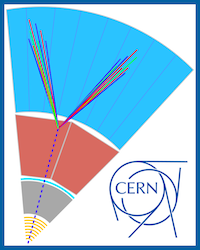Conveners
Dedicated LLP detectors and projects: Session 1
- Albert De Roeck (CERN)
- Karri Folan Di Petrillo (Fermi National Accelerator Lab. (US))
Dedicated LLP detectors and projects: Session 2
- Federico Leo Redi (CERN)
- Louie Dartmoor Corpe (CERN)
Dedicated LLP detectors and projects: Session 3
- Karri Folan Di Petrillo (Fermi National Accelerator Lab. (US))
- Albert De Roeck (CERN)
Dedicated LLP detectors and projects: Session 4
- Margaret Susan Lutz (Tel Aviv University (IL))
- James Beacham (Duke University (US))
We propose a new beam-dump experiment, SHADOWS, to search for a large variety of feebly-interacting particles possibly produced in the interactions of a 400 GeV proton beam with a high-Z material dump. SHADOWS will use the 400 GeV primary proton beam extracted from the CERN SPS currently serving the NA62 experiment in the CERN North area and will take data off-axis when the P42 beam line is...
We studied the feasibility of an experiment searching for sub-millicharged particles (χs) using 30 GeV proton fixed-target collisions at J-PARC. The detector is composed of two layers of stacked scintillator bars and PMTs and is proposed to be installed 280 m from the target. The main background is a random coincidence between two layers due to dark counts in PMTs, which can be reduced to a...
We shall present the latest results from the MoEDAL-MAPP experiment and a review of ongoing and future work on the search for HIPs. In addition, we shall review the status of the MAPP Phase-1 extension to the MoEDAL experiment to be deployed in UA83. the MAPP Phase-1 and Phase-2 detectors are designed to extend the physics reach of MoEDAL to include mCP effectively mCP, LLP and LLCP avatars...
The proposed LUXE experiment (LASER Und XFEL Experiment) at DESY, Hamburg, using the electron beam from the European XFEL, aims to probe QED in the non-perturbative regime created in collisions between high-intensity laser pulses and high-energy electron or photon beams. This setup also provides a unique opportunity to probe physics beyond the standard model. In this talk we show that by...
SND@LHC is a compact and stand-alone experiment to perform measurements with neutrinos produced at the LHC in a hitherto unexplored pseudo-rapidity region of 7.2 < 𝜂 < 8.6, complementary to all the other experiments at the LHC. The experiment is to be located 480 m downstream of IP1 in the unused TI18 tunnel. The detector is composed of a hybrid system based on an 800 kg target mass of...
In the previous LLP workshop we presented our design for the next generation milliQan detectors and their expected combined sensitivity with the Run 3 dataset. For this meeting, we will present the progress on the construction of these detectors, which are planned to be installed in PX56 at LHC P5, above CMS, prior to the start of Run 3.
The FASER experiment consists of two detectors, FASER and FASERnu, that will search for new particles and detect roughly 10,000 neutrino interactions at TeV energies in LHC Run 3. In this talk, we will present updates on the status of these detectors, including their construction, commissioning, results from test beam runs, and future prospects.
The observation of long-lived particles at the LHC would reveal physics beyond the Standard Model, could account for the many open issues in our understanding of our universe, and conceivably point to a more complete theory of the fundamental interactions. Such long-lived particle signatures are fundamentally motivated and can appear in virtually every theoretical construct that address the...
We intend to develop a proposal to search for BSM long-lived particles (LLPs), such as dark photons with mA′ < 20 GeV, in the forward direction of IR5 (CMS), penetrating 35 m– 50 m of steel in the Q1 – Q3 quadrupoles and D1 dipole, and either decaying in a large vacuum pipe or interacting in an imaging calorimeter. Neutral LLPs with |η|> 8 decaying after traversing 83 m of vacuum may also be...
